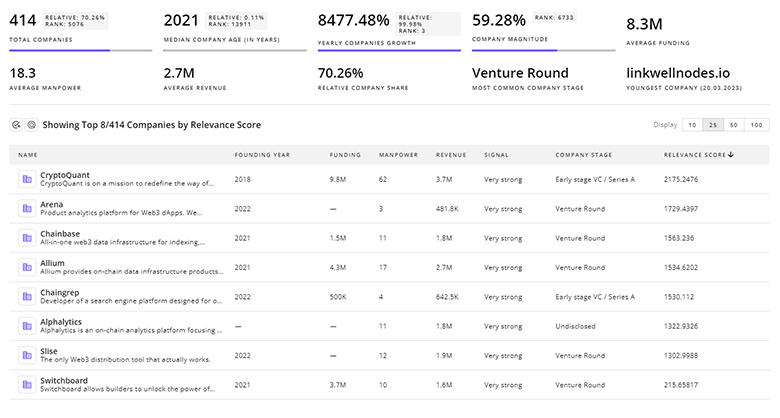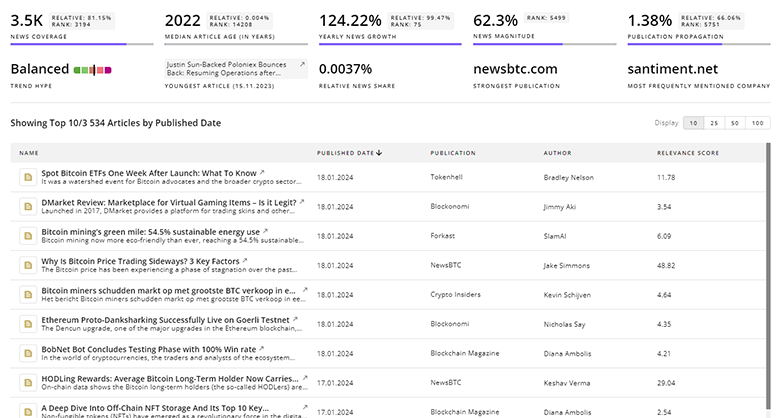Silicon Carbide Semiconductor Report
: Analysis on the Market, Trends, and TechnologiesThe silicon carbide semiconductor market sits at an inflection point: market size is reported at USD 2.10 billion with a projected CAGR of 25.9% and a long-term forecast of USD 21.0 billion, driven by electrification and grid modernization while investors have already poured substantial capital into the space (total funding disclosed at USD 28.44 billion).
53 days ago, we last updated this report. Notice something that’s not right? Let’s fix it together.
Topic Dominance Index of Silicon Carbide Semiconductor
To gauge the influence of Silicon Carbide Semiconductor within the technological landscape, the Dominance Index analyzes trends from published articles, newly established companies, and global search activity
Key Activities and Applications
- EV powertrains (traction inverters, onboard chargers, DC-DC converters). SiC adoption reduces inverter losses and enables 800 V architectures used in high-range EVs.
- Renewable energy power conversion (solar and wind inverters, energy storage converters) where SiC increases conversion efficiency and power density.
- Industrial motor drives and UPS systems that require higher switching frequency and thermal tolerance for smaller, lighter power electronics.
- Data center and AI power infrastructure (high-efficiency, high-density converters) driven by rising power budgets in hyperscale facilities.
- Aerospace, defense, and harsh-environment electronics where SiC's high temperature and radiation tolerance extend operating envelopes.
- Optoelectronics and photonics niches (LEDs, detectors, emerging quantum defect qubits) leveraging SiC's wide bandgap and defect physics.
Emergent Trends and Core Insights
- Wafer scaling to larger diameters materially reduces die cost and enables volume markets. Multiple sources report transitions toward 150 mm / 200 mm (6 inch / 8 inch) and beyond as the primary lever for >40% die-cost reduction by the decade's end, Silicon Carbide MOSFETs Market Opportunity, Growth Drivers, Industry Trend Analysis, and Forecast 2024–2032.
- Automotive pull remains dominant. Automotive powertrains account for the largest share of device demand and are the primary commercial justification for manufacturing scale-up Silicon Carbide Power Semiconductor - Market Share Analysis, Industry Trends & Statistics, Growth Forecasts (2025 - 2030).
- Market forecasts vary in magnitude but align on strong growth. Reported CAGRs cluster between ~17% and >25% through 2029–2034, reflecting differences in scope (raw SiC material versus device/module markets) and optimism about rapid capacity builds Silicon Carbide Market 2025: Detailed Insights into Market Size and Future Growth, Silicon Carbide Semiconductor Market Size, Share, Trends, Growth and Forecast 2032.
- Supply chain and geopolitics shape strategy. Rapid capacity expansion in China and concerted fab investments in Europe and North America create regional specialization and short-term price pressure that accelerates adoption in cost-sensitive segments Non-China supply chain pushes 12-inch SiC into advanced packaging, but China stands to gain.
- Packaging and modules move from component to system differentiation. As device costs fall, value migrates up the stack to module integration, advanced thermal interfaces, and low-parasitic packaging that enable system-level size and efficiency gains, Silicon Carbide Semiconductor Devices Market by Component.
- Reliability and standards are maturing. Industry committees publish MOSFET reliability and test guidance, reducing OEM integration risk and shortening qualification cycles for automotive and grid customers JEDEC Wide Bandgap Power Semiconductor Committee Publishes Documents on Reliability and Testing of Silicon Carbide (SiC) MOSFETs.
Technologies and Methodologies
- Physical Vapor Transport (PVT) boule growth and substrate engineering remain core for high-quality SiC substrates; suppliers refine crucible and furnace designs to increase boule diameter and reduce defect densities.
- Epitaxial deposition improvements (HT-CVD/SiC epitaxy) and tighter defect mapping enable higher yield device layers required for MOSFETs and Schottky diodes, AIXTRON G10-SiC 200 mm system launch coverage.
- Trench and planar SiC MOSFET architectures plus field-plate/guard-ring edge terminations target lower on-resistance and higher breakdown voltages while managing channel reliability.
- Advanced packaging (silver sintering, direct attach thermal interfaces, press-fit and molded modules) reduces parasitics and enables higher switching frequency operation at elevated junction temperatures.
- Wafering, reclaiming, and backside processing services improve material yield economics; reclamation reduces effective substrate cost and shortens time to volume.
- Manufacturing analytics and two-step annealing recipes reduce interface trap densities and improve channel mobility for MOSFETs, improving device consistency for automotive qualification Two-step annealing process boosts silicon carbide device efficiency and reliability.
Silicon Carbide Semiconductor Funding
A total of 197 Silicon Carbide Semiconductor companies have received funding.
Overall, Silicon Carbide Semiconductor companies have raised $20.6B.
Companies within the Silicon Carbide Semiconductor domain have secured capital from 705 funding rounds.
The chart shows the funding trendline of Silicon Carbide Semiconductor companies over the last 5 years
Silicon Carbide Semiconductor Companies
- SiC Systems — SiC Systems builds industrial PVT furnaces for SiC boule growth and complete automated PVT production lines with graphite handling and process-recipe control, positioning them as a supplier to substrate makers and new fabs aiming to scale wafer supply.
- X-trinsic — X-trinsic offers SiC wafering and reclaim services plus process consulting that reduce effective substrate cost and improve time to market for device makers; they target yield recovery and epi-ready wafer supply for small and midscale fabs.
- Nascent Semiconductor — Nascent focuses on radiation-tolerant and high-temperature SiC devices for extreme environments such as oil and gas, aerospace, and space systems; the company's research orientation supports niche, high-margin applications where SiC's material advantages are decisive.
- NEXIC Technology — NEXIC develops 6-inch and 8-inch SiC wafers, discrete chips, and modules for PV inverters, EV motors, and fast chargers; they emphasize an integrated chip-to-module manufacturing chain to capture value as wafer scale increases.
- Mitk Semi — Mitk Semi supplies SiC substrate and epitaxial wafers and is building capacity focused on conductive and semi-insulating SiC materials for 6-inch production, addressing upstream material bottlenecks for device makers.
Get detailed analytics and profiles on 2.1K companies driving change in Silicon Carbide Semiconductor, enabling you to make informed strategic decisions.

2.1K Silicon Carbide Semiconductor Companies
Discover Silicon Carbide Semiconductor Companies, their Funding, Manpower, Revenues, Stages, and much more
Silicon Carbide Semiconductor Investors
TrendFeedr’s Investors tool provides an extensive overview of 925 Silicon Carbide Semiconductor investors and their activities. By analyzing funding rounds and market trends, this tool equips you with the knowledge to make strategic investment decisions in the Silicon Carbide Semiconductor sector.

925 Silicon Carbide Semiconductor Investors
Discover Silicon Carbide Semiconductor Investors, Funding Rounds, Invested Amounts, and Funding Growth
Silicon Carbide Semiconductor News
Explore the evolution and current state of Silicon Carbide Semiconductor with TrendFeedr’s News feature. Access 8.7K Silicon Carbide Semiconductor articles that provide comprehensive insights into market trends and technological advancements.

8.7K Silicon Carbide Semiconductor News Articles
Discover Latest Silicon Carbide Semiconductor Articles, News Magnitude, Publication Propagation, Yearly Growth, and Strongest Publications
Executive Summary
SiC has moved beyond early niche adoption into a scaling phase where wafer diameter, substrate yield, and downstream packaging determine unit economics and addressable markets. Automotive traction inverters created the commercial imperative that justified large capital inflows; as wafer costs decline, SiC will displace silicon in additional high-power, high-temperature, and high-frequency use cases across energy, industrial, and data center infrastructure. Strategic priorities for stakeholders are clear: secure wafer supply or vertically integrate substrate and epi capacity, invest in advanced packaging and module design to capture system value, and align reliability testing and standards work to shorten customer qualification cycles. Companies that coordinate process improvements (growth, epi, wafer reclaim) with module-level engineering will extract the highest margin as SiC expands from specific EV and renewable niches into mainstream power electronics.
We're looking to collaborate with knowledgeable insiders to enhance our analysis of trends and tech. Join us!








